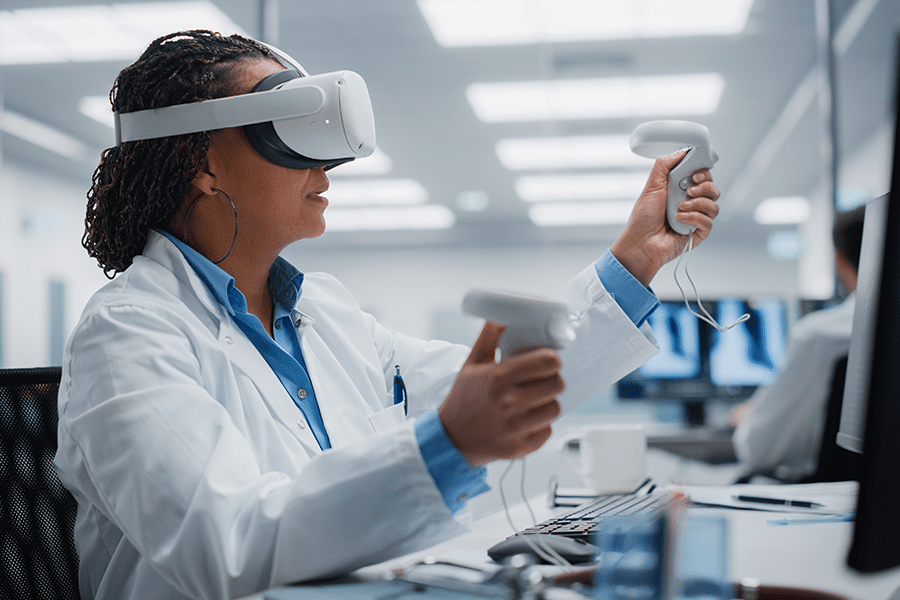A New Breed of Virtual Reality-Enabled Surgeons
VR IS HERE AND READY TO USHER IN A NEW BREED OF TECHNOLOGICALLY-EQUIPPED SURGEONS
Orthopedics has continuously evolved through groundbreaking advancements in imaging technologies. First, it was conventional X-rays, followed by ultrasound, and then computerized tomography (CT) and magnetic resonance imaging (MRI). Every small technological step has massively impacted orthopedic surgeons’ ability to treat musculoskeletal conditions. These advancements have made possible the acquisition of higher-quality images at a faster pace and reduced costs. While higher-quality images are important the next revolutionary breakthrough in imaging may not lie in the acquiring of them but in how these images are displayed, particularly within the realm of extended reality (ER).
Extended reality encompasses various immersive technologies, such as virtual reality (VR), augmented reality (AR), and mixed reality (MR). All of this aims to merge the physical and virtual worlds. Additionally, VR can be enhanced with 3D audio and haptic feedback devices to create a more immersive experience. In the field of medicine, VR has found significant application in simulation-based training, and certain programs even assist with preoperative planning1.
One of the main advantages of VR technology is that it allows for the improvement of the results of procedures before the patient even enters the operating room. Moreover, the importance of VR as an educational tool cannot be overemphasized. It gives surgical trainees the opportunity to learn a variety of techniques that accurately mimic real-life procedures without posing additional risks to patients, requiring expensive resources such as cadavers, or needing supervision. AR-based navigation technologies have also been demonstrated to enhance the precision of component placement in hip and knee arthroplasty2.
Let us first take a glimpse into total knee arthroplasty (TKA). Ensuring the proper placement of components in total knee arthroplasty (TKA) is a must if an implant is to be successful over long term. Usually, surgeons strive for a mechanical axis deviation of less than 3° from the neutral position to prevent early failure, particularly on the tibial side. In 1995, Carnegie Mellon University introduced the HipNav™ system, which utilized CT reconstruction to guide the placement of the acetabular and femoral components before surgery. As part of the planning process, the virtual 3D model with the implanted prostheses could undergo range of motion (ROM) simulation to evaluate implant stability and identify any potential issues like impingement. This capability allowed surgeons to reassess and optimize the positioning of the components3. Similarly, immersive virtual reality (IVR) technologies could and should be employed for 3D templating and preoperative optimization of component positioning in TKA. In fact, this is not a thing of the past anymore. A study was designed to evaluate the effectiveness of immersive VR training in orthopedic surgery education as it compares to the standard technique guide for knee replacement. Amazingly, this study found that residents who trained with the immersive VR executed steps in a better way and completed their training and the procedure in faster time as compared to the group who trained by reading the technique guide, clearly giving them the advantage when compared to their peers4.
Simulation has primarily focused on arthroscopy when it comes to orthopedic surgery, mostly due to the complexity involved in creating a realistic simulated open procedure, such as joint arthroplasty. Studies like the one mentioned above have also been conducted for hip arthroplasty to evaluate the effectiveness of virtual reality (VR) training compared to conventional methods. This study involved a total of 24 surgical trainees (seven female, 17 male) with a mean age of 29 years. Out of these trainees, 12 underwent a six-week VR training program in a simulation laboratory, while the other 12 received only traditional preparatory materials for learning total hip arthroplasty (THA). After the completion of training, all trainees performed a cadaveric THA, which was independently assessed by two hip surgeons. The focus was on evaluating the trainees’ technical and non-technical surgical performance, measured through a THA-specific procedure-based assessment (PBA).
Now at this point, I would like you to guess which group of trainees performed better.
As expected, VR-trained surgeons again performed at a higher level than controls. VR-trained surgeons not only completed 33% more key steps than controls (mean 22 (SD 3) vs 12 (SD 3)), but they were also 12° more accurate in component orientation (mean error 4° (SD 6°) vs 16° (SD 17°) and were 18% faster (mean 42 minutes (SD 7) vs 51 minutes (SD 9)5.
It is no longer a debate that Virtual Reality (VR) is making a difference on both sides of the doctor-patient relationship. By offering a safe space for practice and improvement, real-time access to medical information, and faster preparation for surgical operations, VR technology is paving the way for the development of more skilled surgeons. This has the potential to enhance medical training and minimize the occurrence of surgical errors.
Immersive VR has far greater realism than initially envisaged. A study demonstrating improved Complex Skill Acquisition by Immersive Virtual Reality Training was conducted and it showed that while experts outperformed the resident group on knowledge testing the immersive VR group completed the learning activity and knowledge tests significantly faster (p < 0.001)6.
With its ability to simulate real-life surgical procedures and anatomy in a risk-free environment, Virtual Reality (VR) technology is transforming the way surgeons are trained. By providing a more efficient and effective means for surgeons to hone their skills, VR is producing a new generation of highly skilled medical professionals. This cutting-edge technology has the potential to enhance medical training and reduce surgical errors, making traditional training methods such as working on cadavers a thing of the past. As VR continues to evolve, it is set to become an indispensable tool in the development of top-notch surgeons.
To learn more about how Kinomatic is using virtual reality to improve joint replacement outcomes, head to our website: www.kinomatic.com
